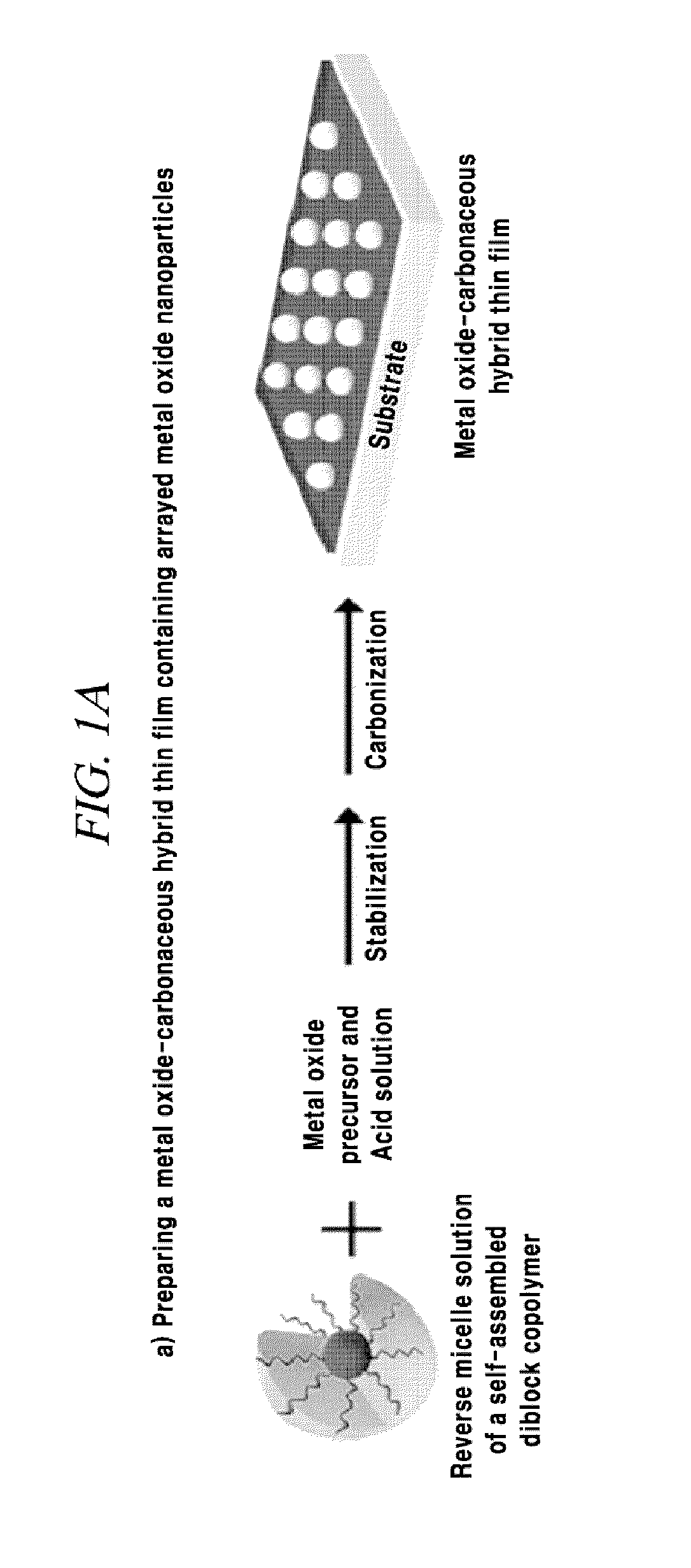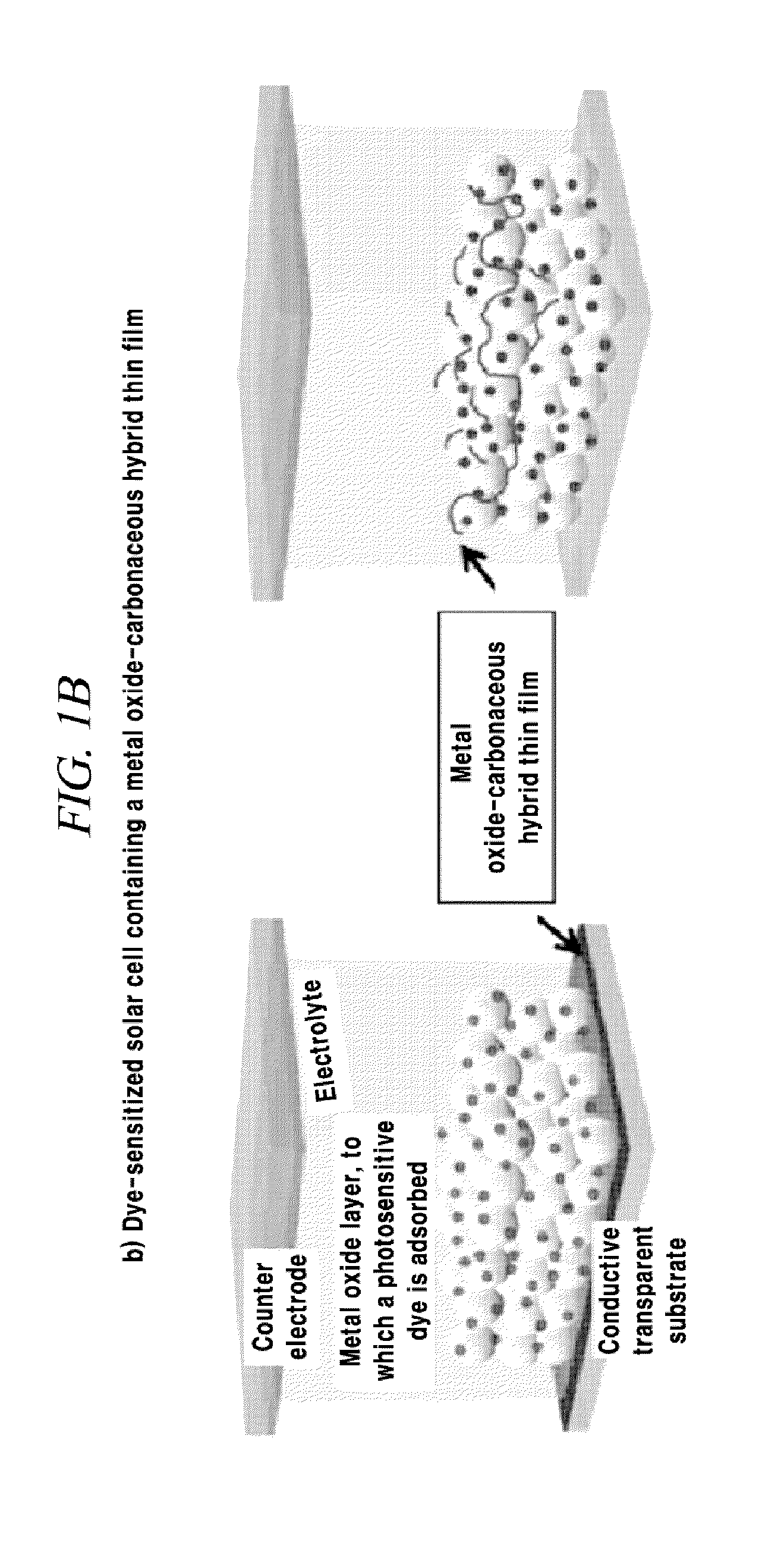Metal oxide-carbonaceous hybrid thin film and preparing method thereof
a technology hybrid thin film, which is applied in the direction of sustainable manufacturing/processing, electrolytic capacitor manufacturing, final product manufacturing, etc., can solve the problems of insufficient research on improving solar cells, and achieves high electrical conductivity, easy and economical preparation of metal oxide carbonaceous, and significant increase of the photo-conversion efficiency of dye-sensitized solar cells
- Summary
- Abstract
- Description
- Claims
- Application Information
AI Technical Summary
Benefits of technology
Problems solved by technology
Method used
Image
Examples
example 1
Preparation of a Titanium Dioxide-Carbonaceous Hybrid Thin Film
(a) Preparation of a Reverse Micelle Solution
[0085]In order to prepare a reverse micelle solution, polystyrene-block-poly(4-vinylpyridine) (PS-b-P4VP, Mn,ps=41,000 g / mol, Mn,P4VP=24,000 g / mol, Mn / Mw=1.09, Polymer Source, Inc.) was used as a self-assembled block copolymer. Toluene was used as a solvent. Specifically, the reverse micelle solution was prepared by dissolving polystyrene-block-poly(4-vinylpyridine) (PS-b-P4VP) in a concentration of approximately 0.5 wt % in toluene.
(b) Preparation of a Titanium Dioxide-Containing Reverse Micelle Solution
[0086]In order to prepare a titanium dioxide-containing reverse micelle solution, a titanium oxide precursor and an acid solution were added to the reverse micelle solution prepared in the step (a). Titanium tetra-isopropoxide (Aldrich), which was used as the titanium dioxide precursor, was added to the reverse micelle solution to have a molar ratio of Ti / 4VP=0.5 to vinylpyrid...
example 2
Preparation I of a Photoelectrode for a Dye-Sensitized Solar Cell Containing the Titanium Dioxide-Carbonaceous Hybrid Thin Film
(1) Preparation of a Conductive Transparent Substrate
[0090]As a conductive transparent substrate included in the photoelectrode for the dye-sensitized solar cell, a fluorine doped tin oxide (FTO) substrate was used in this Example 2. The FTO substrate was used after being washed with each of an acetone solution, a methanol solution, and a 2-propanol solution for 30 minutes through sonification.
(2) Formation of the Titanium Dioxide-Carbonaceous Hybrid Thin Film
[0091]The titanium dioxide-carbonaceous hybrid thin film was formed on the FTO substrate according to the method of Example 1.
(3) Formation of a Titanium Dioxide Layer
[0092]In order to form a titanium dioxide layer on the titanium dioxide-carbonaceous hybrid thin film, a P25 titanium dioxide paste was prepared and used. The P25 titanium dioxide paste was prepared by dissolving approximately 15 wt % of t...
example 3
Preparation II of the Photoelectrode for the Dye-Sensitized Solar Cell Containing the Titanium Dioxide-Carbonaceous Hybrid Thin Film
[0094]The photoelectrode for the dye-sensitized solar cell of Example 3 was prepared by the same step as that of Example 2, except that Example 3 changed the order of the steps (2) and (3) of Example 2 so that the photoelectrode of Example 3 contains a FTO / P25 titanium dioxide layer / titanium dioxide-carbonaceous hybrid thin film.
PUM
| Property | Measurement | Unit |
|---|---|---|
| molar ratio | aaaaa | aaaaa |
| molar ratio | aaaaa | aaaaa |
| temperature | aaaaa | aaaaa |
Abstract
Description
Claims
Application Information
 Login to View More
Login to View More - R&D
- Intellectual Property
- Life Sciences
- Materials
- Tech Scout
- Unparalleled Data Quality
- Higher Quality Content
- 60% Fewer Hallucinations
Browse by: Latest US Patents, China's latest patents, Technical Efficacy Thesaurus, Application Domain, Technology Topic, Popular Technical Reports.
© 2025 PatSnap. All rights reserved.Legal|Privacy policy|Modern Slavery Act Transparency Statement|Sitemap|About US| Contact US: help@patsnap.com



